Liquid, rocket, first ...
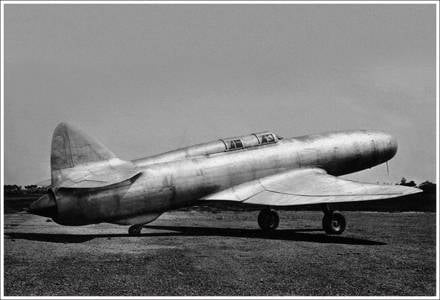
On the morning of March 27, 1943, the first Soviet BI-1 fighter jet took off from the airfield of the Koltsovo Air Force Research Institute in the Sverdlovsk Region. Passed the seventh test flight to achieve maximum speed. Having reached a height of two kilometers and having gained a speed of about 800 km / h, at the 78th second after running out of fuel, it unexpectedly crossed at a peak and collided with the ground. The experienced test pilot G. Ya. Bakhchivandzhi, who was sitting at the helm, died. This disaster was an important stage in the development of aircraft with liquid rocket engines in the USSR, but although work on them continued until the end of the 1940s, this area of development aviation turned out to be a dead end. Nevertheless, these first, although not very successful steps, had a serious impact on the rest of history post-war development of the Soviet aircraft and rocket ...
Joining the "jet" club
“The era of jet airplanes should follow the era of screw airplanes ...” - these words of the founder of jet technology K.E. Tsiolkovsky began to get real incarnation already in the middle of the 1930-s of the XX century.
By this time, it became clear that a further significant increase in the speed of the aircraft due to the increase in power of piston engines and a more perfect aerodynamic form is almost impossible. The aircraft should have installed engines whose power could not be increased without an excessive increase in engine weight. So, to increase the speed of a fighter flight from 650 to 1000 km / h, it was necessary to increase the power of the piston motor 6 (!) Times.
It was obvious that the piston engine would have to be replaced by a reactive one, which, having smaller transverse dimensions, would allow it to reach greater speeds, giving greater thrust per unit of weight.
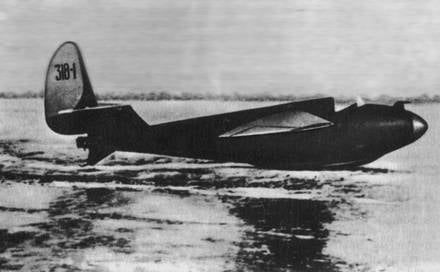
Jet engines are divided into two main classes: air-jet, which use the energy of oxidizing fuel with oxygen from the atmosphere and rocket engines containing all the components of the working fluid on board and capable of working in any environment, including airless. The first type includes turbojet (TRD), pulsating air-jet (PUVD) and direct-flow air-jet (RAMJET), and the second type - liquid-propellant rocket (LPRE) and solid propellant rocket (TDRD) engines.
The first samples of reactive technology appeared in countries where the traditions in the field of the development of science and technology and the level of the aviation industry were extremely high. This is, first of all, Germany, USA, as well as England, Italy. In 1930, the project of the first TRD was patented by the Englishman Frank Whittle, then the first working model of the engine was assembled in HNUMX in Germany by Hans von Ohain, and in 1935 the Frenchman Rene Ledyuk received a government order to create a ramjet…
In the USSR, practical work on the “reactive” theme was conducted mainly in the direction of liquid rocket engines. The founder of the rocket engine in the USSR was V.P. Glushko. He was in 1930, then an employee of the Gas-Dynamic Laboratory (GDL) in Leningrad, which at that time was the only design bureau in the world to develop solid-propellant missiles, created the first domestic LRE-1 rocket engine. And in Moscow in 1931 – 1933. F. L. Zander, a scientist and designer of the Jet Propulsion Study Group (GIRD), developed the LRE RR-1 and RR-2.
A new powerful impetus to the development of reactive technology in the USSR was given by the appointment of M.N. Tukhachevsky in 1931 to the post of Deputy Defense Commissar and Chief of Arms of the Red Army. It was he who insisted on the adoption by the Council of People's Commissars "On the development of steam turbine and jet engines, as well as jet-powered aircraft ..." in 1932. The work started at the Kharkiv Aviation Institute after that allowed only by 1941 to create a working model of the first Soviet TRD designed by A. M. Lyulka and contributed to the launch of 17 in August 1933, the first in the USSR GIRD-09 liquid missile that reached the height of 400 m.
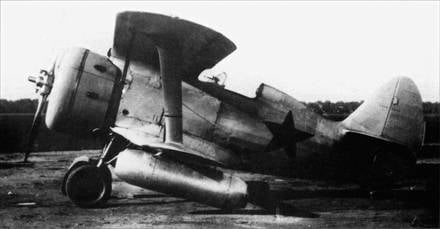
But the absence of more tangible results prompted Tukhachevsky in September 1933 to unite the GDL and GIRD into a single Reactive Research Institute (RNII) headed by Leningrad, military engineer 1 of the rank IT T. Kleymenov. The future Chief Designer of the space program, the Muscovite S. P. Korolev, was appointed his deputy, and two years later in 1935 he was appointed head of the rocket flying apparatus department. And although the RNII was subordinate to the management of ammunition of the People's Commissariat of Heavy Industry and its main theme was the development of missiles (the future Katyusha), Korolev managed together with Glushko to calculate the most profitable design schemes of the apparatus, types of engines and control systems, types of fuel and materials. As a result, in his department, an experimental system of guided missile was developed for 1938. weapons, including projects of liquid cruise "212" and ballistic "204" long-range missiles with gyroscopic control, aircraft missiles for firing at air and ground targets, anti-aircraft solid-fuel missiles, guided by light and radio.
In an effort to get support from the military leadership in the development of the 218 high-altitude rocket plane, Korolev substantiated the concept of a rocket fighter-interceptor capable of reaching a great height in a few minutes and attacking aircraft that had broken through to the protected object.
But the wave of mass repressions that unfolded in the army after the arrest of Tukhachevsky reached RNII. A counter-revolutionary Trotskyist organization was “uncovered” there, and its “participants” I. T. Kleimenov, G. E. Langemak were shot, and Glushko and Korolev were sentenced to 8 years of camps.
These events slowed down the development of jet technology in the USSR and allowed European designers to get ahead. 30 June 1939 German pilot Erich Varzits flew the world's first jet aircraft from the LRE Designer Helmut Walter "Heinkel" He-176, reaching speed in 700 km / h, and after two months and the world's first jet aircraft from the TRD " Heinkel "He-178, equipped with the engine of Hans von Ohain," HeS-3 B "with the 510 kg and speed 750 km / h. A year later, in August, 1940 took off the Italian Kaproni-Campini N1, and in May, 1941 made its first flight by the British Gloucester Pioneer E.28 / 29 with the Whittle TRD W-1 designed by Frank Whittle.
Thus, the leader in the jet race became Nazi Germany, which, in addition to aviation programs, began to launch a missile program under the leadership of Werner von Braun at the secret ground in Peenemünde ...
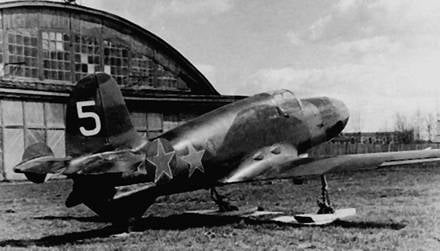
Still, although mass repressions in the USSR caused significant damage, they could not stop all the work on such an obvious reactive topic that Korolev had begun. In 1938, the RNII was renamed to Scientific Research Institute-3, now the “royal” rocket plane “218 – 1” became designated “RP-318 – 1”. New leading designers, engineers A. Shcherbakov, A. Pallo replaced the ORM-65 REM "enemy of the people" V.P. Glushko with the nitrogen-acid-kerosene engine "RDA-1 – 150" designed by L. S. Dushkin.
And almost after a year of testing in February 1940, the first flight of the RP-318 – 1 took place in tow for the P 5 aircraft. Test Pilot? P. Fedorov at the height of 2800 m unhooked the towing cable and launched the rocket engine. A small cloud of an incendiary squib appeared behind the rocket glider, then brown smoke, then a fiery jet about a meter long. “RP-318 – 1”, having developed the maximum speed - only in 165 km / h, went into the flight with climb.
This modest achievement nevertheless allowed the USSR to join the members of the pre-war "jet club" of the leading aviation powers ...
"Middle Fighter"
The successes of the German designers did not go unnoticed by the Soviet leadership. In July, the 1940 of the Committee of Defense under the Council of People's Commissars adopted a resolution determining the creation of the first domestic aircraft with jet engines. The resolution, in particular, provided for the solution of questions “on the use of high-powered jet engines for ultra-high-speed stratospheric flights” ...
The massive Luftwaffe raids on British cities and the lack of a sufficient number of radar stations in the Soviet Union revealed the need to create an interceptor fighter to cover critical facilities, on which young engineers A.Ya. Bereznyak and A.M. Isaev began working on a project from the spring 1941. from Design Bureau Designer V.F. Bolkhovitinov. The concept of their rocket interceptor with the Dushkin engine or “near fighter” was based on the proposal of the Queen, put forward as early as 1938.
When the enemy aircraft appeared, the “near fighter” had to quickly take off and, possessing a high rate of climb and speed, catch up and destroy the enemy in the first attack, then after working out the fuel, using the reserve height and speed, plan for landing.
The project was notable for its extraordinary simplicity and cheapness - the whole construction had to be solid wood of plywood. The engine frame, pilot and chassis protection were made of metal, which were removed under the influence of compressed air.
Since the beginning of the war Bolkhovitinov attracted to the work on the aircraft all the bureau. In July 1941, a conceptual design with an explanatory note was sent to Stalin, and in August the State Defense Committee decided to urgently build an interceptor, which was necessary for parts of Moscow’s air defense. According to the order by the People's Commissariat of the aircraft industry, 35 days were assigned for the manufacture of the machine.
The aircraft, known as "BI" (near fighter or, as journalists later interpreted, "Bereznyak - Isaev") was built almost without detailed working drawings, drawing its size in plywood on the plywood. The skin of the fuselage was glued on the disc from veneer, then attached to the frame. The keel was carried out together with the fuselage, as well as the thin wooden wing of the caisson structure, and covered with a canvas. There was even a wooden carriage for two 20-mm ShVAK cannons with 90 ammunition. LRE D-1 A-1100 was installed in the rear fuselage. The engine consumed 6 kg of kerosene and acid per second. The total fuel supply on board the aircraft, equal to 705 kg, ensured engine operation for almost 2 minutes. Estimated take-off weight of the aircraft "BI" was 1650 kg with a mass of empty 805 kg.
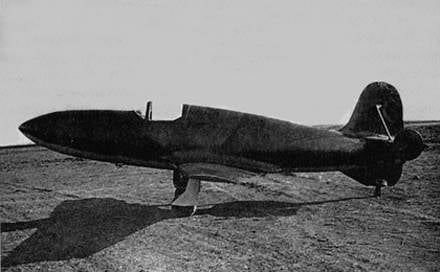
In order to reduce the time it took to create an interceptor at the request of A. S. Yakovlev, Deputy People's Commissar of the Aviation Industry for a pilot aircraft, the BI planer's glider was investigated in the TsAGI full-scale wind tunnel, and test pilot BN Kudrin began running and landing on a tug at the aerodrome . With the development of the power plant had to pretty tricky, since nitric acid was corroding tanks and wiring and had a harmful effect on humans.
However, all work was interrupted in connection with the evacuation of the design bureau to the Urals in the village of Belimbai in October 1941. There, in order to debug the work of the LRE systems, a ground stand was mounted - the BI fuselage with a combustion chamber, tanks and pipelines. By the spring of 1942, the ground test program was completed. Soon, Glushko, released from prison, familiarized himself with the design of the aircraft and the bench test facility.
Flight tests of the unique fighter were assigned to captain Bakhchivandzhi, who made 65 combat missions at the front and shot down 5 German planes. He previously mastered the management of systems on the stand.
The morning of May 15 1942 was forever entered the history of Russian cosmonautics and aviation, the take-off from the ground of the first Soviet aircraft with a liquid jet engine. The flight, which lasted 3 min 9 seconds at speed 400 km / h and with a climb rate - 23 m / s, made a strong impression on all those present. This is how Bolkhovitinov recalled this in 1962: “For us on the ground, this take-off was unusual. Unusually quickly picking up speed, the plane took off from the ground in 10 seconds and disappeared from 30 seconds in the eyes. Only the flame of the engine spoke about where it is located. So a few minutes passed. I will not hide, my hocks began to shake. ”
Members of the state commission noted in an official act that “the take-off and flight of an BI-1 aircraft with a rocket engine, first used as the main engine of an aircraft, proved the possibility of practical implementation of flying on a new principle, which opens up a new direction for the development of aviation.” The test pilot noted that the flight on the BI plane was exceptionally pleasant compared to the usual types of aircraft, and the plane is superior to other fighters in ease of operation.
A day after the tests in Bilimbay, a solemn meeting and a rally were arranged. Over the presidium table hung a poster: "Hello to Captain Bakhchivandzhi, the pilot who flew to the new!"
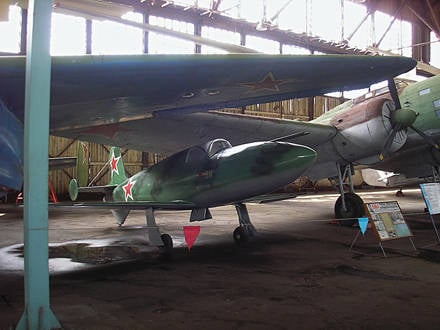
Soon followed the decision of the State Defense Committee to build a series of 20 planes "BI-VS", where, in addition to the two guns, a bomb cassette was installed in front of the cockpit, which contained ten small anti-aircraft bombs weighing 2,5 kg.
A total of 7 test flights were made on the BI fighter, each of which recorded the best flight performance of the aircraft. The flights took place without flight accidents, only during landing there was a slight damage to the chassis.
But 27 March 1943 r. When overclocked to speed 800 km / h at a height of 2000 m, the third prototype spontaneously went into a dive and crashed into the ground near the airfield. The commission investigating the circumstances of the crash and the death of the test pilot Bakhchivandzhi could not establish the reasons for the delay in the aircraft, noting that the phenomena occurring at flight speeds of the order of 800 –1000 km / h have not been studied.
The catastrophe hurt the reputation of the Bolkhovitinov Design Bureau - all the unfinished BI-Sun interceptors were destroyed. And although later in 1943 – 1944. A modification of the BI-7 with ramjet engines at the ends of the wing was designed, and in January 1945 the pilot B.N. Kudrin performed the last two flights on the BI-1; all work on the aircraft was stopped.
And yet the LRE
The concept of a rocket fighter was most successfully implemented in Germany, where, starting in January, 1939 was in a special “Department L” of the Messerschmitt company, where Professor A. Lippish with his staff went from the German Glider Institute to work on “Project X” - “ object "interceptor" Me-163 "" Komet "with LRE, working on a mixture of hydrazine, methanol and water. It was an aircraft of an unconventional "tailless" scheme, which for the sake of maximum weight reduction took off from a special trolley, and landed on a ski that was being pulled out of the fuselage. The first flight on the maximum test pilot Ditmar performed in August 1941, and already in October for the first time in history the mark in 1000 km / h was overcome. It took more than two years of testing and refinement before Me-163 was launched into the series. It became the first aircraft from the LRE, which participated in the battles from May 1944. And although until February 1945 was launched over 300 interceptors, in the ranks were no more than 80 combat-ready aircraft.
The combat use of Me-163 fighters showed the inconsistency of the missile interceptor concept. Due to the high speed of convergence, the German pilots did not have time to precisely aim, and the limited supply of fuel (only for 8 minutes of flight) did not give an opportunity for a second attack. After the development of fuel on planning interceptors became easy prey for American fighters - "Mustangs" and "Thunderbolts." Before the end of hostilities in Europe, "Me-163" shot down 9 enemy aircraft, while losing 14 machines. However, losses from accidents and catastrophes were three times higher than combat. The unreliability and short range of the Me-163 contributed to the fact that the management of the Luftwaffe launched into mass production other Me-262 and Non-162 fighter jets.
The leadership of the Soviet aviation industry in 1941 – 1943. It focused on the gross output of the maximum number of combat aircraft and the improvement of production models and was not interested in the development of promising work on jet technology. Thus, the crash of "BI-1" put an end to other projects of the Soviet missile interceptors: "302" by Andrei Kostikova, "R-114" by Roberto Bartini and "RP" Korolev. Here, the mistrust that Yakovlev, the deputy of Stalin for experimental aircraft building, felt for jet technology, considered it a matter of a very distant future, played its part.
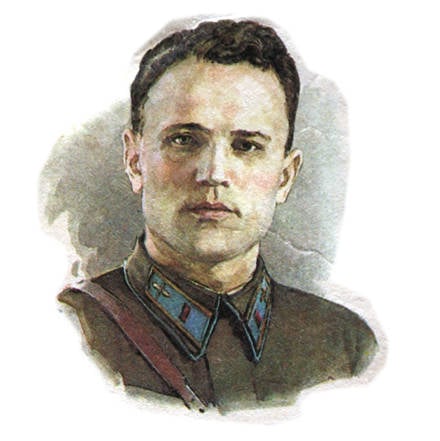
But information from Germany and the Allied countries caused 1944, in February, the State Defense Committee, in its resolution, indicated an intolerable situation with the development of reactive technology in the country. At the same time, all developments in this respect were now concentrated in the newly organized scientific research institute of jet aircraft, Bolkhovitinov was appointed deputy head of which. In this institute, groups of jet engine designers led by M. M. Bondaryuk, V. P. Glushko, L. S. Dushkin, A. M. Isaev, AM Lyulka, who previously worked at various enterprises, were assembled.
In May, the GKO 1944 adopted another resolution outlining a broad program for the construction of jet aircraft. This document provided for the creation of modifications of the Yak-3, La-7 and Su-6 with accelerating rocket engine, the construction of a "purely missile" aircraft Yakovlev and Polikarpov, experimental aircraft Lavochkin with TRD, and fighters with air-breathing motorokompressornymi engines in OKB Mikoyan and dry. For this, the Su-7 fighter was created in the Sukhoi design bureau, in which the liquid-reactive RD-1 developed by Glushko worked together with a piston motor.
Flights to the Su-7 began in 1945. When the RD-1 was turned on, the aircraft speed increased on average by 115 km / h, but the tests had to be stopped due to frequent failure of the jet engine. A similar situation exists in the design offices of Lavochkin and Yakovlev. On one of the experimental aircraft "La-7 P" accelerator exploded in flight, the test pilot miraculously escaped. During the test, "Yak-3 RD" test pilot Viktor Rastorguev managed to reach speed in 782 km / h, but during the flight the plane exploded, the pilot died. Frequent accidents led to the fact that the tests of the aircraft with the "RD-1" were stopped.
Contributed to this work and released from prison Korolyov. In 1945, for his participation in the development and testing of rocket launchers for Pe-2 and La-5 VI military aircraft, he was awarded the Badge of Honor.
One of the most interesting interceptor projects with a rocket engine was the project of a supersonic (!!!) fighter "РМ-1" or "САМ-29", developed at the end of 1944 by undeservedly forgotten aircraft designer A. S. Moskalev. The aircraft was carried out according to the “flying wing” scheme of a triangular shape with oval leading edges, and during its development the pre-war experience of creating Sigma and Strela aircraft was used. The project "RM-1" should have the following characteristics: crew - 1 man, power plant - "РД2 МЗВ" with 1590 kgf thrust, wing span - 8,1 m and its area - 28,0 м2, take-off weight - 1600 kg, maximum speed - 2200 km / h (and this is in 1945!). TsAGI believed that the construction and flight tests of the RM-1 was one of the most promising areas in the future development of Soviet aviation.
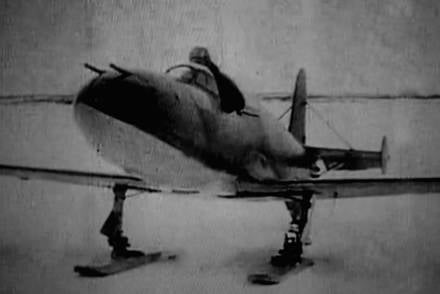
In November 1945, the order to build the “RM-1” was signed by Minister A.I. Shakhurin, but ... in January, the notorious “aviation case” was launched on 1946, and Shahurin was convicted, and the order to build the “RM- 1 ”canceled by Yakovlev ...
Post-war acquaintance with German trophies revealed a significant lag in the development of domestic jet aircraft. To reduce the gap, it was decided to use the German engines "JUMO-004" and "BMW-003", and then based on them to create their own. These engines received the name "RD-10" and "RD-20".
In 1945, simultaneously with the task to build a MiG-9 fighter with two RD-20, the Mikoyan Design Bureau was tasked with developing an experimental interceptor fighter with an RD-2 M-3 B LRE and 1000 km / h speed. The aircraft, which received the designation I-270 (“F”), was soon built, but its further tests did not show the advantages of the rocket fighter over the aircraft from the TRD, and work on this topic was closed. In the future, liquid jet engines in steel aviation will be used only on experimental and experimental aircraft, or as aircraft accelerators.
They were the first
“... It is terrible to remember how little I then knew and understood. Today they say: "discoverers", "pioneers." And we walked in the dark and stuffed huge cones. No literature, no methods, no well-established experiment. Stone Age of jet aircraft. We were both finished mugs! .. ”- so recalled the creation of“ BI-1 ”Alexey Isaev. Yes, indeed, because of their colossal fuel consumption, aircraft with liquid-rocket engines did not take root in aviation, forever giving way to turbo-jets. But having made their first steps in aviation, the LRE firmly took their place in rocket production.
In the USSR during the war in this respect, the creation of the BI-1 fighter was a breakthrough, and here Bolkhovitinov's special merit was that he took under his wing and managed to bring to work such future luminaries of the Soviet rocketry and cosmonautics as: Vasily Mishin, First Deputy Chief Korolev designer, Nikolai Pilyugin, Boris Chertok - chief designers of control systems of many combat missiles and carriers, Konstantin Bushuev - project manager of the Soyuz - Apollon project, Alexander Bereznyak - designer of cruise missiles, Alexey Isaev - p zrabotchik LRE missile submarines and spacecraft, Arkhip Lyulka - author and developer of the first domestic turbojet engines ...
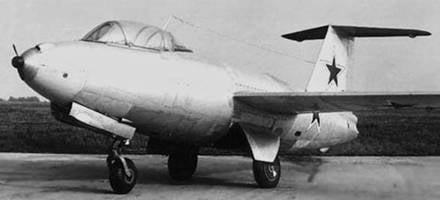
Received the clue and mystery of the death of Bakhchivandzhi. In 1943, a high-speed T-106 wind tunnel was commissioned at TsAGI. It immediately began to conduct extensive studies of models of aircraft and their elements at high subsonic speeds. The model of the BI was also tested to identify the causes of the disaster. According to the test results, it became clear that the “BI” crashed due to the peculiarities of the flow around a straight wing and feathering at transonic speeds and the occurrence of a plane pulling into a dive, which the pilot could not overcome. Catastrophe 27 March 1943 "BI-1" was the first to allow Soviet aircraft designers to solve the problem of "wave crisis" by installing an arrow-shaped wing on the MiG-15 fighter. After 30 years in 1973, Bahchivandzhi was posthumously awarded the title Hero of the Soviet Union. Yuri Gagarin said about him:
"... Without the flights of Grigory Bakhchivandzhi, it would not have been possible for 12 of April of 1961 either." Who could know that exactly after 25 years, 27 March 1968, like Bakhchivandzhi at the age 34 years, Gagarin will also die in a plane crash. They were really united by the main thing - they were the first.
Information